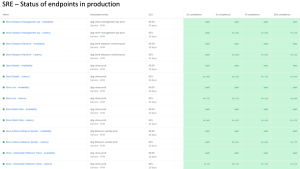As the software industry increases its focus on environmental, social, and wider sustainability practices, there’s been a rise in new reporting regulations. Regulations like the EU’s Due Diligence proposal put the onus on large and medium companies to identify, prevent, or mitigate damaging environmental and human rights in their practices. The EU’s Taxonomy for Sustainable Activities identifies six environmental objectives for EU-based companies to focus on. Work is now underway to create new metrics and key performance indicators (KPIs) to monitor these actions and communicate them publicly for transparency.
Build or buy?
To fully track your data across your entire supply chain, you'll need to build a dashboard that utilizes data visualization and your regulatory reporting data. With this information in a single interface, you can monitor your carbon footprint and perform benchmarking tests to meet your targets. To implement a dashboard into your tech stack, you have two options: build your own or buy one off the shelf.
Building a dashboard increases your initial workload and lengthens the time to deployment, but it also lets you customize data taxonomies and categories to meet your company’s exact regulatory needs. Here are four steps to start with:
- Get access to ESG data and supplier databases.
- Invest in a monthly or yearly subscription to license the ESG data set. The license cost varies depending upon the number of companies included in the dataset and the length of time covered by the data.
- Connect the databases to a central dashboard.
- Categorize your suppliers’ data to fit into your reporting metrics.
Companies can also buy off-the-shelf solutions including pre-made ESG dashboards with taxonomy definitions and category matching for supplier data in place, with options to address different regulatory standards.
Common features in ESG dashboards
Features you’ll find in most ESG dashboards include:
- Automated data collection and aggregation.
- Portfolio-level insights.
- Benchmarking against peers.
- Compliance with the EU’s Sustainable Finance Strategy.
- Sustainability taxonomy and the Sustainable Finance Disclosure Regulation (SFDR).
- Sustainable Development Goals (SDG) setting and tracking.
- Many ESG dashboards do not share data sources, but two datasets are regularly referenced: REFINITIV and CSRHub.
Many dashboard providers also have the following privacy tools and methods to make sure supply chain data remains commercial in confidence and to prevent attacks:
- 2-factor authentication.
- Dedicated client servers.
- Admin-controlled whitelisted IPs.
- Infrastructure and application vulnerabilities monitoring.
- Monitoring threats with a managed security service provider (MSSP).
- ISO 27001 compliance certification.
- Consumer data protection laws on where dashboard providers are headquartered.
7 important metrics
As new regulations require companies to report on their environmental and social impact, ESG dashboards will become a common tool. To ensure that reporting meets regulatory compliance, data needs to be tracked. Monitoring metrics fall into three categories: integration ops, data ops, and machine learning ops.
1. CPU and memory usage
What it is: The amount of processing power used by your dashboard’s API server to run or consume APIs used in your dashboard.
How to measure it: CPU and memory usage can be measured by installing a cluster in the server that hosts your API code.
Integration Ops monitor the performance of ESG dashboard APIs. Keeping track of dashboard API performance lets you know if you are running as expected, as well as alert you to any unnecessary energy expenditures that could be reduced.
2. API consumption
What it is: The volume of requests your APIs receive per second/minute.
How to measure it: Application monitoring tools like New Relic’s APM track API consumption. To lessen the strain on your dashboard APIs, consider combining multiple API calls into a single call with a flexible pagination scheme.
3. Response time
What it is: The time elapsed between when an API request is made and when it was completed. For example, the amount of time between selecting a list of SDGs in your ESG dashboard and that list loading.
How to measure it: Accurate response time can be difficult to measure since latency issues can stem from multiple locations (API endpoints or the network itself, for example).
Data Ops look at data validation within your ESG dashboard. To ensure you’re meeting sustainability goals, your inputted data should be logged fully and accurately.
4. Data volume
What it is: The amount of data you input into the ESG dashboard’s database. By keeping track of data volume, you ensure that all your inputted data has successfully integrated into the database.
How to measure it: Compare the number of new items sent to the database against the number of new items shown in the database—the two numbers should be equal.
5. Corrupted data
What it is: Data errors that occur during transfer or processing. A data error could result in an empty value in your database, which could make future calculations inaccurate if not fixed.
How to measure it: Your combined total of alerts that have been issued with empty or null responses.
Machine Learning Ops monitor how an ESG dashboard utilizes machine learning to analyze and generate useful data based on previously-taught data models. While working on large quantities of data, your ESG dashboard needs to accurately interpret taxonomy classifications and make reliable calculations of future events.
6. Data invariance
What it is: The dashboard’s ability to recognize when data doesn’t adhere to a predetermined schema. For example, an inputted data set that doesn’t match up to the sustainability taxonomy it has been trained to recognize.
How to measure it: Your management system should issue an alert if data is incompatible with recognized schemas.
7. Training and serving features
What it is: Tests that determine if the data output in your training environment (where the machine learns data models that form the basis of its future calculations) matches the output of your serving environment (where the calculations take place). For example, if you’ve trained your ESG dashboard to calculate weighted metrics where the sustainability reputation of a company in your supply chain affects another, such as a seller and buyer, those prediction values need to be calculated consistently and accurately.
How to measure it: Calculate distribution statistics, like minimum and maximum values, on the training and serving environments to ensure they match.
Nächste Schritte
Keep reading: Three steps to ideating green tech products.
Build your ESG dashboard in New Relic
- Sign up for a free account with 100 GB/month of data ingest.
- See all the ways you can send data to New Relic.
- Learn how to create your dashboards.
- Get complete app visibility from backend APIs to frontend devices.
- Deploy log management in context to instantly correlate events in your applications, infrastructure, serverless, and mobile errors.
Die in diesem Blog geäußerten Ansichten sind die des Autors und spiegeln nicht unbedingt die Ansichten von New Relic wider. Alle vom Autor angebotenen Lösungen sind umgebungsspezifisch und nicht Teil der kommerziellen Lösungen oder des Supports von New Relic. Bitte besuchen Sie uns exklusiv im Explorers Hub (discuss.newrelic.com) für Fragen und Unterstützung zu diesem Blogbeitrag. Dieser Blog kann Links zu Inhalten auf Websites Dritter enthalten. Durch die Bereitstellung solcher Links übernimmt, garantiert, genehmigt oder billigt New Relic die auf diesen Websites verfügbaren Informationen, Ansichten oder Produkte nicht.



